
Simon Sudbury was Bishop of London from 1361 to 1375, Archbishop of Canterbury from 1375 until his death, and in the last year of his life Lord Chancellor of England. He met a violent death during the Peasants' Revolt in 1381.

St Luke's Church, Farnworth, Widnes, is a church in Farnworth, which was once a separate village but which is now part of the town of Widnes, Cheshire, England. The church dates back to the 12th century and it contains a number of items of historical interest, in particular hatchments and memorials. It is recorded in the National Heritage List for England as a designated Grade II* listed building, and is an active Anglican parish church in the diocese of Liverpool, the archdeaconry of Warrington and the deanery of Widnes.

St Nicholas Church is a Church of England parish church in Kenilworth, Warwickshire, England.
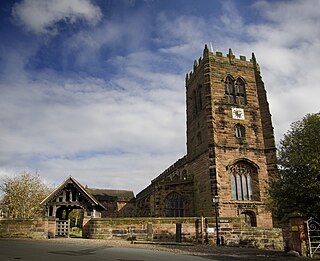
St Mary and All Saints Church is in the centre of the village of Great Budworth, Cheshire, England. It is an active Anglican parish church in the diocese of Chester, the archdeaconry of Chester and the deanery of Great Budworth. The church is recorded in the National Heritage List for England as a designated Grade I listed building. Clifton-Taylor includes it in his list of 'best' English parish churches. Richards describes it as "one of the finest examples of ecclesiastical architecture remaining in Cheshire". The authors of the Buildings of England series express the opinion that it is "one of the most satisfactory Perpendicular churches of Cheshire and its setting brings its qualities out to perfection".

St Oswald's Church is in the village of Lower Peover, Cheshire, England. It is recorded in the National Heritage List for England as a designated Grade I listed building. It is an active Anglican parish church in the diocese of Chester, the archdeaconry of Macclesfield and the deanery of Knutsford. Its benefice is combined with that of St Lawrence, Over Peover.

St Bartholomew's Church is in the town of Wilmslow, Cheshire, England. The church is recorded in the National Heritage List for England as a designated Grade I listed building. It is an active Anglican parish church in the diocese of Chester, the archdeaconry of Macclesfield and the deanery of Knutsford.

St Mary's Ecumenical Church is a Church of England / Methodist Local Ecumenical Project in the village of Weaverham, Cheshire, England. The church is the parish church of Weaverham and Acton Bridge and part of the Methodist Northwich and Winsford Circuit. The vision of the church is to share the light and hope of Jesus with the local community. The church building is recorded in the National Heritage List for England as a designated Grade I listed building. It is an active Anglican parish church in the Diocese of Chester, the archdeaconry of Chester and the deanery of Middlewich.

St Oswald's Church is north of the village of Brereton Green, adjacent to Brereton Hall, in the civil parish of Brereton, Cheshire, England, on the banks of the River Croco. It is recorded in the National Heritage List for England as a designated Grade II* listed building, and is described as "an unusually complete late Perpendicular church". It is an active Anglican parish church in the diocese of Chester, the archdeaconry of Macclesfield and the deanery of Congleton. Its benefice is combined with those of Christ Church, Eaton, and St Michael, Hulme Walfield.

St Nicholas Church is in the village of Burton, Ellesmere Port and Neston, Cheshire, England. It is recorded in the National Heritage List for England as a designated Grade II* listed building. It is an active Anglican parish church in the diocese of Chester, the archdeaconry of Chester and the deanery of Wirral South. Its benefice is combined with that of St Michael, Shotwick.
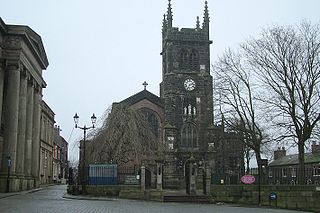
St Michael and All Angels Church overlooks Market Place in the town of Macclesfield, Cheshire, England. It is an active Anglican parish church in the diocese of Chester, the archdeaconry of Macclesfield and the deanery of Macclesfield. It forms a team parish with three other Macclesfield churches: All Saints, St Peter's and St Barnabas'. The church is recorded in the National Heritage List for England as a designated Grade II* listed building.

St Mary's Church in Cheadle, Greater Manchester, England, is a Grade I listed building. It is an Anglican parish church in the diocese of Chester, the archdeaconry of Macclesfield and the deanery of Cheadle. Its benefice is united with that of St Cuthbert.

St Bartholomew's Church is in the town of Colne in Lancashire, England. It is an active Anglican parish church in the Diocese of Blackburn. There has been a church on the site since no later than the 12th century although the present building mostly dates from the 16th century. It is recorded in the National Heritage List for England as a designated Grade I listed building.

St Mary's Church is a redundant Anglican church in St Mary's Place, Shrewsbury, Shropshire, England. It is recorded in the National Heritage List for England as a designated Grade I listed building, and is under the care of the Churches Conservation Trust, the Trust designated St Mary's as its first Conservation Church in 2015. It is the largest church in Shrewsbury. Clifton-Taylor includes the church in his list of 'best' English parish churches.
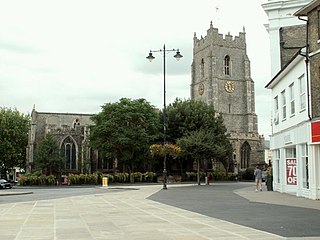
St Peter'sChurch, Sudbury is a former Anglican church in the town of Sudbury, Suffolk, England, which now serves as an Arts Centre. The building is recorded in the National Heritage List for England as a designated Grade I listed building, and is under the care of the Churches Conservation Trust. The building stands in the heart of the town in a dominating position on Market Hill.

St Denys' Church is a medieval Anglican parish church in Sleaford, Lincolnshire, England. While a church and a priest have probably been present in the settlement since approximately 1086, the oldest parts of the present building are the tower and spire, which date to the late 12th and early 13th centuries; the stone broach spire is one of the earliest examples of its kind in England. The Decorated Gothic nave, aisles and north transept were built in the 14th century. The church was altered in the 19th century: the north aisle was rebuilt by the local builders Kirk and Parry in 1853 and the tower and spire were largely rebuilt in 1884 after being struck by lightning. St Denys' remains an active parish church.

St James, Norton is the Church of England parish church of the Norton district of Sheffield, South Yorkshire, England.
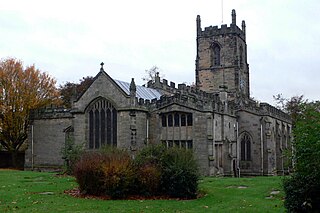
St Helen's Church is the Anglican parish church of Ashby-de-la-Zouch, in the deanery of North West Leicestershire and the Diocese of Leicester. There was a church in the town in the 11th century, but the core of the present building mainly dates from work started in 1474, when the church was rebuilt by William Hastings at the same time that he converted his neighbouring manor house into a castle. The church was refurbished in about 1670 to create more space, but the large and increasing size of the congregation led to further work in 1829, and a major rebuild in 1878–80, including the widening of the nave by the addition of two outer aisles.

St Mary's Church, Higham Ferrers is a Church of England parish church in Higham Ferrers, Northamptonshire. It is a Grade I listed building.
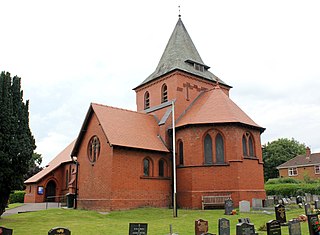
All Saints Church, Great Saughall, is located in Church Road in the civil parish of Saughall and Shotwick Park, formerly Saughall and before that Great Saughall, in the county of Cheshire, England. It is an active Anglican parish church in the deanery of Wirral South, the archdeaconry of Chester, and the diocese of Chester. The church is recorded in the National Heritage List for England as a designated Grade II listed building.
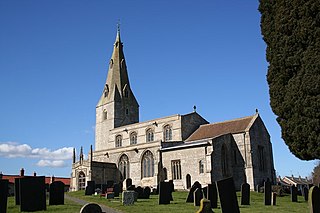
St Peter's Church is a Grade I listed Anglican parish church dedicated to Saint Peter, in Ropsley, Lincolnshire, England. The church is 5 miles (8 km) east from Grantham, and in the South Kesteven Lincolnshire Vales. St Peter's is in the ecclesiastical parish of Ropsley, and is part of the North Beltisloe Group of churches in the Deanery of Beltisloe, and the Diocese of Lincoln.
























